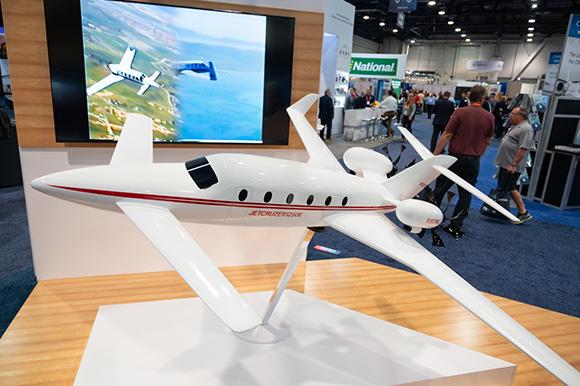
LAS VEGAS—California-based Jetcruzer International has unveiled plans to develop a zero-emission hydrogen-electric advanced air mobility vehicle based on the defunct canard-configured Jetcruzer single-engined turboprop.
Displayed in model form at NBAA, the 10-seat Jetcruzer 1250E is outlined with twin, tail-mounted pusher props powered by hydrogen-electric fuel-cells. However, the company, which acquired the intellectual property and assets of the original Jetcruzer producer Advanced Aerodynamics and Structures Inc (AASI) seven years ago, first plans to pave the way for the 1250E by testing an electric-powered version of the turboprop Jetcruzer 450/500.
Simon Roads, vice president of Sales Marketing, Business Development at Jetcruzer, says the single-engine Jetcruzer 450/500 pusher will be used “like the testbed. What we'd like to do is get it to the point where we're selling this [the Jetcruzer 500] with a gas turbine—but by the end of the first quarter next year we'll have another airplane with an electric motor.”
Developed in the 1980s, the AASI Jetcruzer was conceived as a low-cost transport with seating for up to six in its production form. Powered by a Rolls-Royce 250 single turboprop in its prototype form, and a Pratt & Whitney Canada (P&WC) PT6 in the stretched Jetcruzer 500 configuration first shown at NBAA in Las Vegas in 1998, the design was noteworthy for being the first aircraft to have achieved a spin-resistance certification from the FAA.
The 1250E project is based on groundwork already performed for a long-range turbofan-powered version called the Stratocruzer 1250 outlined in the early 1990s.
Despite decades of development and tests the Jetcruzer never entered production and the assets were acquired in 2016 by Victor Tao, president of Ontario, California-based Farrar Aerospace. Tao is now also vice president of engineering for Jetcruzer International. The assets included at least two shipsets of fuselages and wings. “So we're going to electrify one of them, and we'll start testing with that in the first quarter next year,” says Roads. The choice of motor supplier has yet to be decided, he adds.
“We’ve got a couple of really strong candidates for this, and I personally think hydrogen fuel cells are the way to go,” says Roads, who anticipates entry into service later in the decade. “We will match the certification efforts of the motors, and we know that 2026-27 is realistic. So, the goal is to get this done.”
The program to resume Jetcruzer 450 production with a P&WC PT6-66B is expected to get off to a swift start based on the product’s existing type certificate. “So we can get this gas turbine version done relatively quickly—probably within 12 months,” says Roads.
“We're going through the research and development stage now and we've got some very keen investors in this project,” he adds. Jetcruzer says its clean approach to the design, rather than adapting to an existing aircraft, will be an advantage. “We are working with a few manufacturers about how we design around what we need to make this viable and with the right range. It’s sized for 10 passengers and 300-400 nm, but we also want to be able to do a cargo configuration,” says Roads. The company is also looking at a potential business aviation version with a galley and seating for four to six passengers.
Discussions are also underway over a potential production site at French Valley airport, California.

Comments